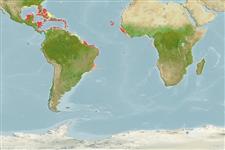>
Eupercaria/misc (Various families in series Eupercaria) >
Labridae (Wrasses)
Etymology: Doratonotus: Latin, deauratus = golden + Greek, noton = back (Ref. 45335).
More on author: Günther.
Environment: milieu / climate zone / depth range / distribution range
Ecologia
marino associati a barriera corallina; distribuzione batimetrica 1 - 15 m (Ref. 9710). Tropical; 33°N - 29°S, 98°W - 10°E
Western Atlantic: Bermuda and southern Florida, USA to Brazil (Ref. 57756). Eastern Atlantic: Cape Verde Is, and São Tomé.
Size / Peso / Age
Maturity: Lm ? range ? - ? cm
Max length : 9.4 cm TL maschio/sesso non determinato; (Ref. 9626); peso massimo pubblicato: 10.80 g (Ref. 9626)
Spine dorsali (totale) : 9; Raggi dorsali molli (totale) : 10; Spine anali: 3; Raggi anali molli: 9. Color primarily grass green; usually some scattered small white or pale blue spots on head and body; small reddish brown spot near upper edge of caudal fin and another near lower edge (Ref. 13442).
Inhabits shallow beds of turtle grass (Thalassia). Common but seldom noticed (Ref. 9710).
Life cycle and mating behavior
Maturità | Riproduzione | Deposizione | Uova | Fecundity | Larve
Oviparous, distinct pairing during breeding (Ref. 205).
Robins, C.R. and G.C. Ray, 1986. A field guide to Atlantic coast fishes of North America. Houghton Mifflin Company, Boston, U.S.A. 354 p. (Ref. 7251)
IUCN Red List Status (Ref. 130435: Version 2024-1)
Threat to humans
Harmless
Human uses
Pesca: commerciale; Acquario: Commerciale
Strumenti
Special reports
Download XML
Fonti Internet
Estimates based on models
Preferred temperature (Ref.
123201): 26.1 - 28.2, mean 27.4 °C (based on 549 cells).
Phylogenetic diversity index (Ref.
82804): PD
50 = 1.0000 [Uniqueness, from 0.5 = low to 2.0 = high].
Bayesian length-weight: a=0.01096 (0.00647 - 0.01859), b=3.04 (2.89 - 3.19), in cm total length, based on LWR estimates for this species & (Sub)family-body (Ref.
93245).
Trophic level (Ref.
69278): 3.3 ±0.4 se; based on size and trophs of closest relatives
Resilienza (Ref.
120179): Alto, tempo minimo di raddoppiamento della popolazione meno di 15 mesi (Preliminary K or Fecundity.).
Fishing Vulnerability (Ref.
59153): Low vulnerability (10 of 100).
Nutrients (Ref.
124155): Calcium = 128 [74, 235] mg/100g; Iron = 0.868 [0.485, 1.651] mg/100g; Protein = 18.5 [15.6, 20.7] %; Omega3 = 0.161 [0.096, 0.267] g/100g; Selenium = 19.7 [10.8, 37.7] μg/100g; VitaminA = 163 [48, 637] μg/100g; Zinc = 2.04 [1.34, 3.22] mg/100g (wet weight);
